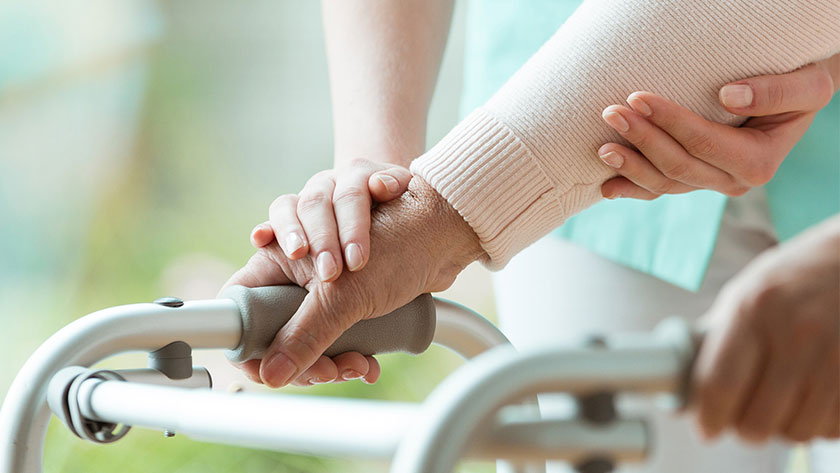Overcome 3 nursing home obstacles to improve wound healing
When nursing home patients follow treatment plans, wounds can heal faster. Find out how you can support your patients.

When nursing home patients follow treatment plans, wounds can heal faster. Find out how you can support your patients.
There are many reasons why patients don’t, can’t or won’t adhere to directed treatment. It’s a universal healthcare problem, but in nursing homes, three key issues stand out:
- Malnutrition
- Patient educational barriers
- Lack of trust in care providers
Read more about patient compliance
Malnutrition: the hidden danger in wound care
According to the Alliance for Aging Research, 35% to 85% of adults in long-term care facilities experience malnutrition, particularly because they are more likely to have chronic conditions that may make eating difficult or unappealing, affect their metabolism, or require dietary restrictions.1 While malnutrition is harmful in itself, the problem goes beyond that. Among many consequences, malnutrition adversely affects wound management,2 making it doubly important for you to help your patients comply with their nutritional needs.

“Adequate nutritional intake plays a vital role in wound healing, because the body relies on macronutrients, such as proteins, so it can create the assorted tissue and cells required to heal, or close, the wound.”
– Matt Hoffman, DNP, APRN, FNP-C, Clinical Assistant Professor, Texas A&M College of Nursing Faculty Chair
One meaningful way to help nursing home patients achieve nutritional goals is to use a protein supplement such as Active Liquid Protein. Still, patients sometimes have negative experiences with supplements and dismiss them or dislike how they taste, so here’s a tip from Vista Manor Nursing and Rehabilitation Center in San Jose, California: They created Active pancakes, incorporating the Active Liquid Protein supplement into a recipe for protein-rich—and tasty—pancakes. Residents couldn’t even tell the difference between the Active pancakes and regular pancakes.
In the spirit of collaboration, reaching out to a nutritionist or registered dietician is also helpful. This gives patients another resource to help identify foods they will enjoy, meet their individualized nutritional needs and support wound healing, says Matt Hoffman, DNP, APRN, FNP-C, Clinical Assistant Professor, Texas A&M College of Nursing Faculty Chair.
Read more about Nutrition and Diabetes
Knowledge gaps: what patients need to know
It’s easy to assume that patients understand what they’re supposed to do—what to eat and when to take medication, for example—but they often don’t.3 This lack of knowledge means you may need to take a moment to put yourself in their shoes, then offer some extra education. “The best tool any nurse can use to help the patient with their wound healing process is to provide education and help them understand how all the subtle, seemingly unrelated, aspects of their care are working together,” Hoffman says. He adds that it may be important to also educate loved ones so they can help reinforce compliance.

“It’s not to say, ‘Take this pill or I’ll be frustrated’ or ‘Obey me or I’ll feel disrespected.’ It’s understanding why there are some people who do not do what’s in their best interests—and that requires gentle and persistent communication.”
– Dr. Kenneth Goodman, PhD, FACMI, FACE, Director, Institute for Bioethics and Health Policy, Co-Director, University of Miami Ethics Programs
Trust issues: relationships matter
There’s more to the patient-clinician relationship than a mere “exchange of orders and responses,” says Dr. Kenneth Goodman, PhD, FACMI, FACE, Director, Institute for Bioethics and Health Policy, Co-Director, University of Miami Ethics Programs. A great deal of that relationship is built on trust, which often begins with nurses, especially for the most vulnerable patients, Dr. Goodman notes.
“The problem is, we beleaguer nurses in lots of different ways and, when time is a scarce commodity, trust takes a hit,” Goodman acknowledges. But he encourages nurses to take the time to build that trusting relationship. “What patients want is someone who gets them,” Dr. Goodman says. “And I am convinced that sustained, gentle communication and support will do far more to improve adherence than laying down the law.”
In closing, keep patients engaged in treatment
Your goal to heal or improve wounds can be hindered by patients who don’t adhere to treatment plans. “If you don’t get patients as active participants in the team, no technical or scientific skill is going to win the day,” Goodman points out. “We’ve got to get patients, including the most difficult ones, to be active members of the team.” You can help improve outcomes by finding creative ways to encourage proper nutrition, by guiding patients through gentle teaching, and by building trust.
Learn more about treating the whole patient:
Nutritional intervention: Three important nutrients essential to improving skin health
Download wound-specific handouts to help improve patient education
Better nutrition, better outcomes
References:
- Alliance for Aging Research, “Malnutrition: Healthcare Professional Tip Sheet,” https://www.agingresearch.org/document/malnutrition-healthcare-professional-tip-sheet/
- Molnar JA, Underdown MJ, Clark WA. Nutrition and Chronic Wounds. Adv Wound Care (New Rochelle). 2014;3(11):663–681. doi:10.1089/wound.2014.0530
- U.S. Department of Health and Human Services- America’s Health Literacy: Why We Need Accessible Health Information https://health.gov/communication/literacy/issuebrief/
